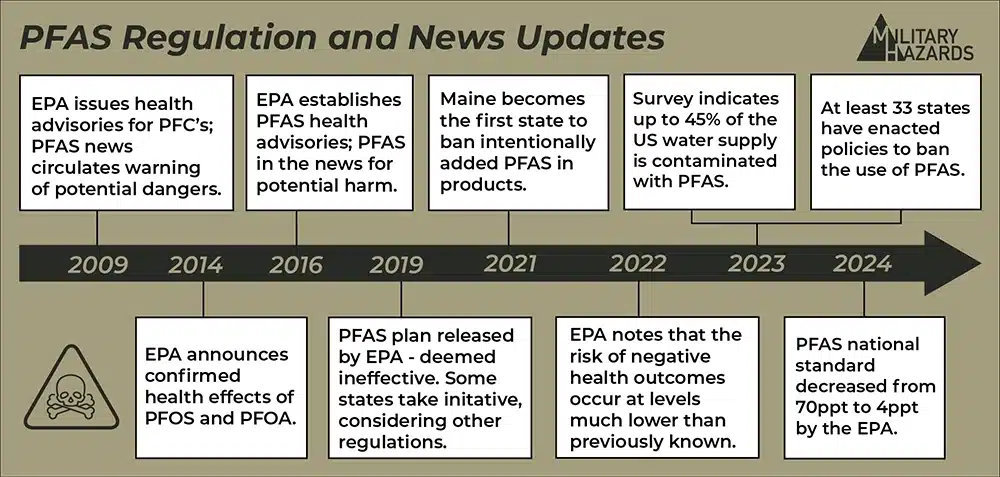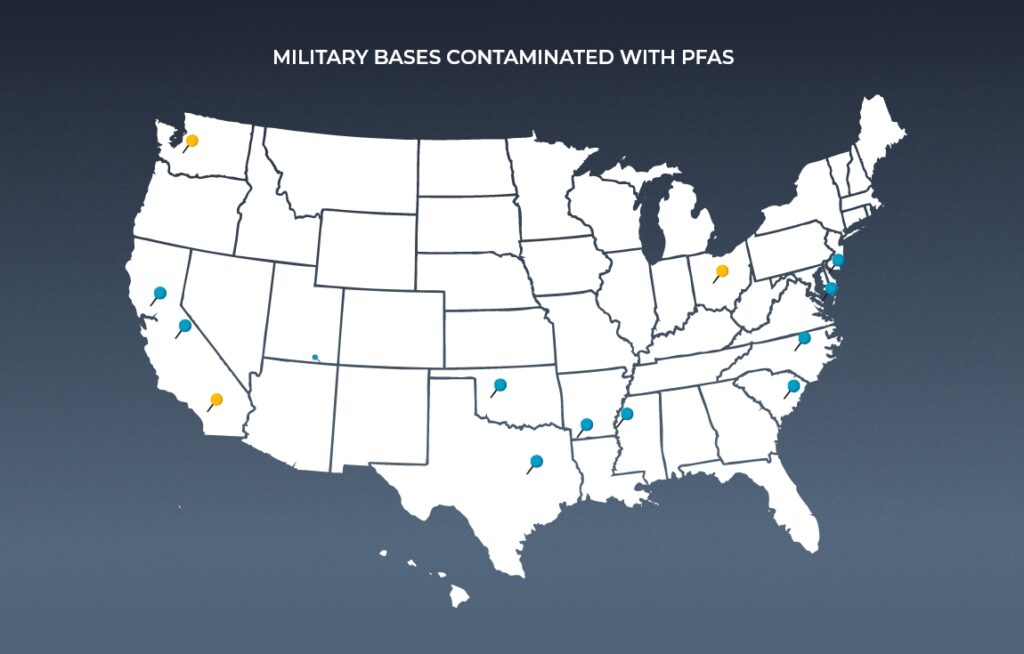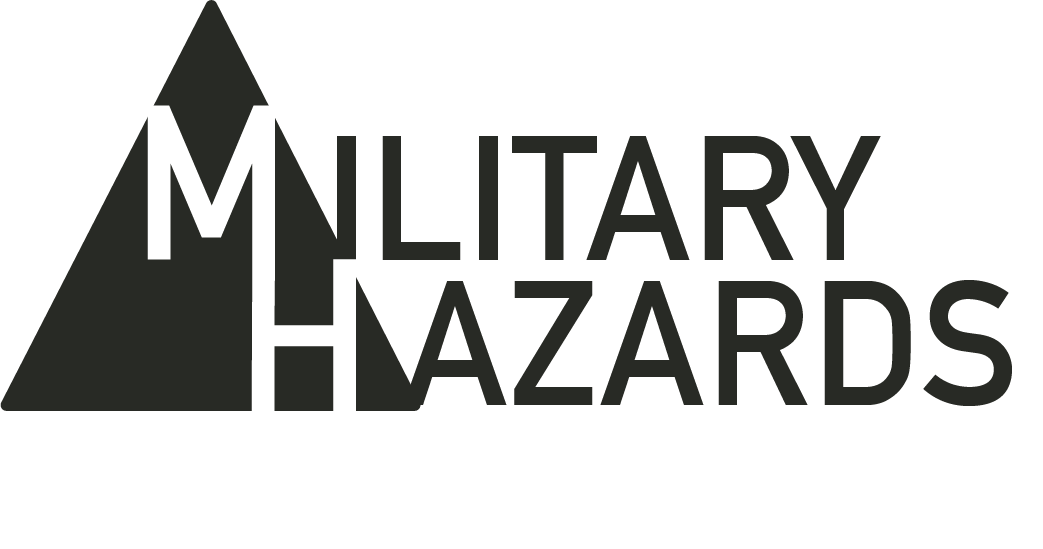Contact Our Legal Partner
"*" indicates required fields

PFAS News and Regulation Updates
September 2023 – At least 33 states have enacted policies limiting or banning the use of PFAS. 27 state attorney generals have filed lawsuits against manufacturers for their use of PFAS.
August 2023 – A study by the U.S. The Geological Survey indicates that up to 45% of the nation’s water supply is contaminated with PFAS chemicals.
May 2023 – Minnesota enacts legislation to ban products with intentionally added PFAS. The full ban will take effect in 2032.
June 2022 – The Environmental Protection Agency revises its Health Advisory Levels (HALs), noting that the risk of negative health outcomes occurs at levels much lower than previously understood by the Agency.
July 2021 – Maine becomes the first state to enact legislation to ban intentionally added PFAS in products. The ban will become effective in 2030.
February 2019 – The Environmental Protection Agency releases a PFAS plan. The plan is dismissed as ineffective at preventing PFAS in the nation’s water supply or consumer products. Absent comprehensive federal reform, states begin to consider banning PFAS in food packaging and firefighting foam. Several states also consider other PFAS regulations, such as limiting the levels of PFAS to be allowed in drinking levels.
November 2016 – The Environmental Protection Agency establishes health advisories for PFOA and PFOS. PFOAs and PFOSs are part of a larger group of “forever” chemicals known as PFASs. The EPA also updates their known health effects from exposure to these chemicals. PFAS in the news for potential harm to humans.
February 2014 – The EPA releases known health effects for PFOAs and Perfluorooctane Sulfonates (PFOSs).
January 2009 – The Environmental Protection Agency (EPA) issues provisional health advisories for the levels of perfluorooctanoic acid (PFOA) and other perfluorinated chemicals (PFCs). The provisional health advisories state that the link between exposure to PFOAs and adverse health outcomes is inconclusive. PFAS news circulates about the potential dangers.
What Is PFAS?
PFAS, also known as per- and polyfluoroalkyl substances, are a group of man-made or synthetic chemicals used across the globe in various industries since the 1940s. The chemicals are composed of carbon and fluorine atoms linked in a strong bond, rendering them persistent in the environment. They are used throughout the manufacturing process and in consumer products. Studies show that they are also found in the nation’s water supply.
PFAS does not refer to a single chemical. PFAS stands for a group of substances containing thousands of chemicals, including well-studied ones like PFOA and PFOS. Often referred to as “forever” chemicals, these substances are persistent, breaking down slowly and accumulating over time in the environment, humans, and animals.
Due to their wide usage and persistence, they are found across the globe in various elements, including water, air, soil, and even in the blood of humans and animals. PFAS has been linked to potentially harmful health effects in both humans and animals. Several states have enacted legislation banning or limiting the use of PFAS in products. Unfortunately, the vast number of PFAS chemicals and their presence in a wide range of products makes it challenging to study and assess potential risks to human health and the environment.

What Chemicals Are in PFAS?
The Organisation for Economic Co-operation and Development (OECD) defines PFAS as “ fluorinated substances that contain at least one fully fluorinated methyl or methylene carbon atom (without any H/Cl/Br/I atom attached to it).” There are at least 4,730 distinct PFASs with at least three perfluorinated carbon atoms. It is believed, however, that there are tens of thousands, if not millions, unique PFAS chemical compounds.
List of PFAS Chemicals:
- PFOA (perfluorooctanoic acid)
- PFOS (perfluorooctane sulfonic acid)
- PFHxS (perfluorohexane sulfonic acid)
- PFNA (perfluorononanoic acid)
- HFPO (hexafluoropropylene oxide) dimer acid and its ammonium salt (GenX chemicals)
- PFBS (perfluorobutane sulfonic acid and potassium perfluorobutane sulfonate)
While PFOA and PFOS have generally been phased out of production in the United States, they are still likely in production in other countries.
PFAS Contamination in the Military
In April 2022, the U.S. Department of Defense announced that they would phase out the use of Aqueous Film Forming Foam Usage (AFFF) at their military bases. AFFF is a fire-extinguishing agent that is known to contain PFAS (primarily PFOA and PFOS).
The Department of Defense began using AFFF in the 1970s as a way to fight fuel fires. The use of the PFAS-containing fire-extinguishing agent is believed to have contributed to significant groundwater contamination on military bases nationwide. It is estimated that over 700 military sites in the country have been affected.
Despite acknowledging the dangers of PFAS exposure and that there are hundreds of contaminated military locations, the U.S. Department of Veterans Affairs (VA) does not provide automatic coverage for veterans exposed to the toxic chemical. Cases are decided on a case-by-case basis. Legislation was introduced in June 2023 to require the VA to provide health care services to veterans exposed to PFAS. The Veterans Exposed to Toxic (VET) PFAS Act would require coverage for illnesses related to PFAS military contamination.
Common PFAS Exposures in the Military
Individuals who suffered military PFAS exposure may be entitled to compensation. The primary way veterans were exposed to forever chemicals was through contaminated drinking water. The military’s continued use of Aqueous Film Forming Foam Usage (AFFF) or firefighting foam caused significant run-off into the environment and water supply.
Military Sources of PFAS:
- Chemical fires or spills
- Vapor suppression systems at plating shops
- Crash crew training exercises
- Hanger system operations and testing
- Emergency response actions
PFAS military contamination is thought to be widespread, with countless veterans and their families suffering irreparable harm. Despite federal agencies such as the Agency for Toxic Substances and Disease Registry (ATSDR) noting the potential health risks of PFAS-containing products in 2019, the military continues to use them.
Military Bases with PFAS Contamination
A recent Department of Defense study shows that over 175,000 service members are exposed annually to dangerous PFOA and PFOS levels at 24 installations. Water tests showed that PFAS concentrations exceeded both the past (70 ppt) and current (1 ppt) EPA safety standards.
List of Military Bases with PFAS Contamination:
- Joint Base Lewis-McChord (high PFAS levels found)
- Wright-Patterson Airforce Base, Ohio (high PFAS levels found)
- Marine Corps Base – Camp Pendleton (high PFAS levels found)
- Joint Base Pearl Harbor-Hickam
- Fort Hood, Texas
- Fort Bragg, North Carolina
- Altus Air Force Base
- Barksdale Air Force Base
- Charleston Air Force Base
- Dover Air Force Base
- England Air Force Base
- Langley Air Force Base
- Naval Air Weapons Station China Lake
- Travis Air Force Base
These are only a few of the PFAS military bases. The Pentagon has made slow progress with its cleanup initiatives. Tragically, PFAS-containing products continue to be used by our military. You may be entitled to compensation if you had military toxic exposure.

PFAS Symptoms and Health Effects
In humans, exposure to PFAS can have continuing adverse health effects. The forever chemicals build up in the body over time from food or drink consumption. The health impacts of PFAS are widespread and deeply concerning.
Studies indicate that PFAS can lead to:
- Changes to the immune system
- Thyroid problems
- Negative cardiovascular and metabolic effects
- Increased cholesterol levels
- Altered metabolism
- Developmental effects or delays in children
- Higher blood pressure during pregnancy
- Decreases in infant birth weights
- Reduced fetal growth
- Decreased vaccine response in children
- Changes in liver enzymes
- Increased risk of cancer
PFAS has been linked with an increased risk of kidney, prostate, and testicular cancer. If you suffer from PFAS symptoms or the negative health effects of PFAS, you may be entitled to financial recovery.
How to Avoid PFAS
Because the chemicals do not break down easily, it can be hard to completely avoid PFAS exposure, but you can limit it. The best way to avoid PFAS chemicals and exposure is by prioritizing reducing exposure through drinking water and food. It is important to know that the body does eliminate PFAS over time. Therefore, a reduction in exposure can help reduce the negative impacts of the forever chemicals.
You can also learn how to avoid PFAS by researching the PFAS levels in your local water supply or using NSF/ANSI-certified filters for purification. Avoid swallowing water from natural water bodies, and always wash your hands after contact with foams or water from natural water sources such as rivers, lakes, and streams. Be sure to rinse or shower after being in one of these bodies of water.
Since PFAS are frequently used in food packaging, you may want to consider reducing your intake of fast food and takeout in order to limit exposure to PFAS. It is also recommended that you transfer food out of packaging and reheat it in your own container. Stain-resistant products should be avoided, and check to make sure that your cookware is PFAS-free.
List of Products with PFAS
Products with PFAS are found on shelves throughout the United States. It can be challenging to know which products contain PFAS since it may be listed as a specific chemical.
List of products with PFAS:
- Aqueous Film Forming Foam Usage (AFFF) or firefighting foam
- Non-stick cookware
- Stain-resistant furniture and carpet
- Cleaning products
- Cosmetics
- Shampoo
- Dental floss
- Nail polish
While many products and textiles contain PFAS, one of the most common ways people are exposed is through their drinking water. Decades of use of PFAS have led to the contamination of groundwater in the United States, eventually entering our water supply. Get more information about what to do if you were exposed at a military base or another location.
What to Do if You’ve Been Exposed to PFAS
If you have been exposed to PFAS, you should obtain a blood test to know your current PFAS levels. While the test does not determine “safe” or “unsafe” levels, it can help you assess the severity of your exposure.
In the event that you are experiencing adverse health effects from PFAS exposure, you should consult with a doctor. You should also discuss potential legal actions with a lawyer if exposure is due to negligence.
While PFAS chemicals are hard to completely eradicate from your body, removing the source of PFAS exposure from your environment can help. Unfortunately, most people in the U.S. have measurable levels of PFAS due to its common usage in various products.
Frequently Asked Questions (FAQs)
Does Brita remove PFAS?
As reported by the Los Angeles Times, common water filters such as Britas are not designed to remove PFAS. There are, however, home water filtration systems on the market that can help reduce the levels of PFAS in your water supply.
Is PFAS exposure a VA disability?
Legislation was recently introduced that would require the U.S. Department of Veterans Affairs (VA) to provide “health services and disability benefits” to servicemembers who have been exposed to PFAS at military bases.
Why are PFAS called “forever chemicals?”
PFAS chemicals are extremely difficult to break down, their strong bond makes them resistant to heat and other elements. Since they are challenging to break down in the body and the environment, they are referred to as forever chemicals.
How much PFAS is dangerous?
For many PFAS, the EPA recommends exposure to under 1 part per trillion (ppt). PFAS, however, are so widely used that it can be challenging to know when you are being exposed.
Does boiling water remove PFAS?
Boiling water will not remove PFAS.
Does reverse osmosis remove PFAS?
Reverse osmosis is the most effective way to remove PFAS from your water supply.
Why do military bases have PFAS?
It is believed that the widespread use of the fire-fighting foam AFFF led to run off which contaminated the ground and drinking water of military bases across the country.
Does PFAS cause cancer?
Studies indicate that there may be a link between PFAS and certain kinds of cancer.
When did the military stop using PFAS?
The military, in some cases, still uses PFAS, although they have committed to finding a PFAS-free option.
What is PFAS in the military?
PFAS in the military refers to military sites or specific people who were exposed to PFAS at their military base. If you sustained military PFAS exposure, contact our office.
Does the military still use PFAS?
It is believed that the military continues to use PFAS.
Where does PFAS come from?
PFAS are man-made or synthetic substances that are present in our drinking water and consumer products.
How can you remove PFAS from water?
The best way to remove PFAS from water is by using reverse osmosis.
Does bottled water have PFAS?
According to the Food and Drug Administration, PFAS has been found on some water bottles.
Can PFAS be filtered out of water?
It can be exceptionally difficult to get PFAS out of filtered water. Normal home filtration systems are not designed for the removal of PFAS, but there are some commercial-grade water filtration systems that can help.
How does PFAS get into water?
PFAS can get into the water through runoff.
